Dolby Atmos is a new surround sound technology that is designed to make your audio listening experience better on a wide range of devices, including Windows 10/11 devices. In this post, we’ll tell you how to fix Dolby Atmos not working in Windows 10/11?
If you have this problem, you can try the solutions below in no particular order to see if they help.
- Update sound drivers
- Rollback sound drivers
- Run the built-in sound troubleshooter
- Enable Exclusive mode options
- Run downloadable troubleshooter
- Reconfigure Dolby Atmos for your device or try Sonic
- Update Windows
Let’s take a look at the description of the process involved concerning each of the listed solutions.
How To Fix Dolby Atmos not working on Windows 10/11
Before you try any of the solutions below, check for updates and install any available bits on your Windows 11/10 device. Then check to see if Dolby Atmos works as it should.
Method 1. Update sound drivers
1. Right-click on the Start menu and select Device Manager from the Power User menu..
2. Expand the Sound, video, and game controllers section.
3. Right-click both onboard sound device and third-party device and select Update drivers.
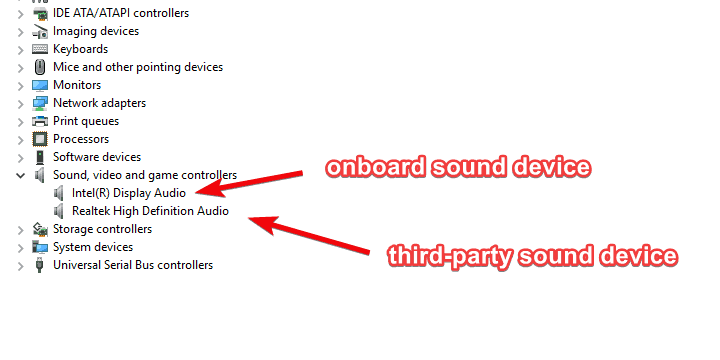
4. Restart your system.
5. In the Notification area, right-click on the Sound icon and select Spatial Sound (Dolby Atmos for Headphones). If you haven’t done so before, simply follow the on-screen directions.
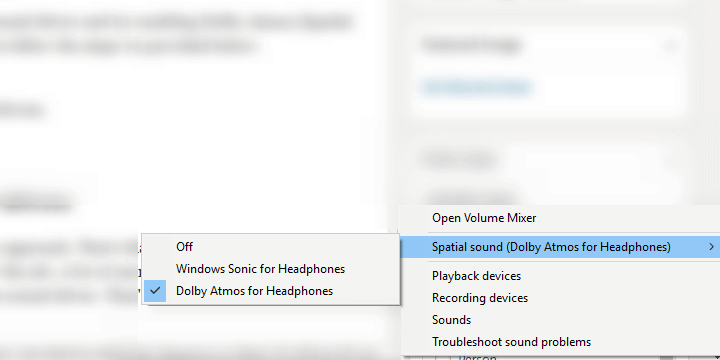
6. Play supported content and look for (listen to) changes in the way it looks or sounds.
They are the main reason things go bad. It’s likely that you already know that there are usually two sound devices with their own jobs and drivers to help them work.
There is a built-in sound system and a third-party one. People who use Windows 10 are used to having automatic driver updates, but they often make things even worse.
As a result, it looks like some versions of both the onboard sound device and the third-party device (Realtek, VIA, ATI) won’t work with Dolby Atmos and Spatial Sound as well as they should.
Try updating your sound driver first. Then, try enabling Dolby Atmos (Spatial sound) and see if that helps.
If you don’t know how to do this on your Windows 10, make sure you get an automated solution that can do this for you.
We like Driver Easy because it is very easy to use and it doesn’t use a lot of system resources. If you want to make sure your drivers are always updated and fixed, you can use this.
Method 2. Rollback sound drivers/stick with native drivers
1. Go to Device Manager.
2. Expand the Sound, video, and game controllers section, then right-click both devices, respectively, and click Properties.
3. Go to the Driver tab, click Roll Back driver.
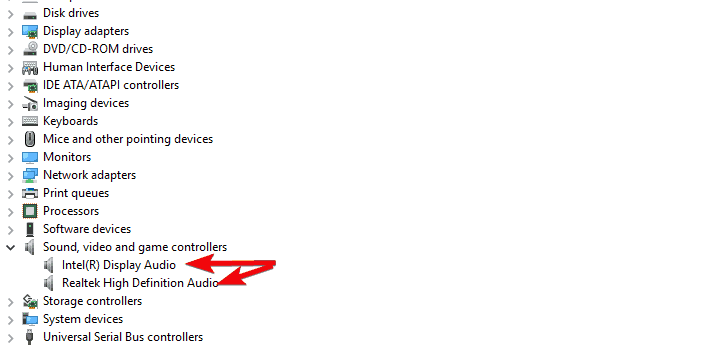
4. If that doesn’t work, go back and right-click on the third-party sound device and remove it.
5. Reboot your system and re-enable Spatial sound.
If the first step didn’t help at all, we suggest taking a completely different one. In fact, the most recent version of the driver might not be the best for the job.
Try to roll back the driver on all of your sound devices and see if there are any changes.
The problem will be solved if you roll back your driver. If that doesn’t work, you will have to stop Windows from automatically updating the driver in the future.
If that doesn’t work, you should turn off the third-party sound device and only use the onboard sound.
Method 3. Run the built-in sound troubleshooter
1. Open Settings by pressing Windows + I.
2. Select Update & Security.
3. In the left pane, click Troubleshoot.
4. A troubleshooter called “Playing Audio” is highlighted. You can then click to run it.
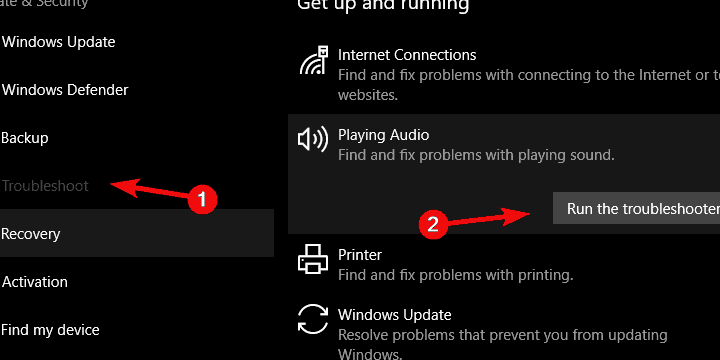
5. After the troubleshooter is done with its job, restart your PC.
6. When you open the Sound icon, go to Spatial sound, and try to turn on Dolby Atmos for the first time again.
The Windows Troubleshooter for Playing Audio should help with some minor problems, especially those caused by updates.
Method 4. Enable Exclusive mode options
1. Right-click on the Sound icon in the Notification area and choose Playback devices from the drop-down menu that pops up.
2. Right-click on your default Playback device and go to Properties, then click OK.
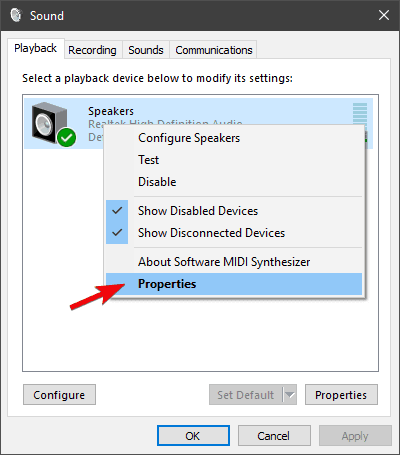
3. Before you do anything else, go to the Spatial sound tab and make sure Dolby Atmos for headphones is turned on.
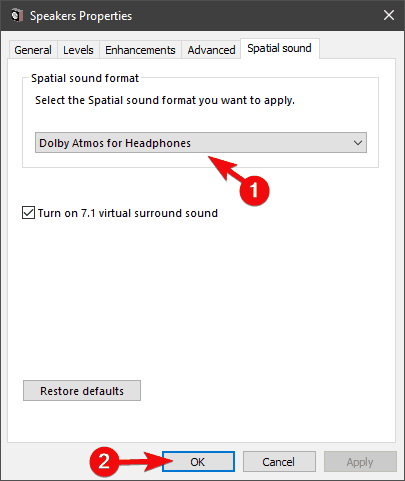
4. Go to the Advanced tab.
5. When you’re in Exclusive mode, make sure that both Allow applications to take exclusive control of this device and Give exclusive application priority are checked.
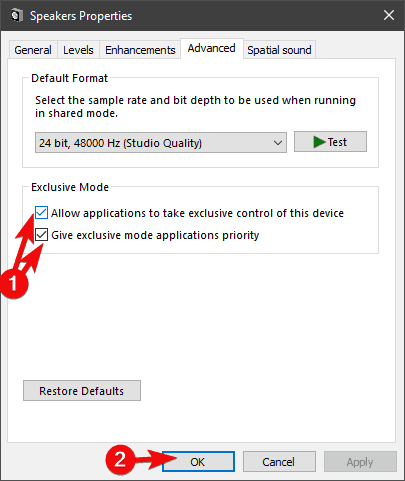
6. Check to see if Spatial sound features are working now or if they have changed.
Some third-party apps for playing and re-playing audio tend to take control of things on their own, rather than relying on system resources.
As of now, Windows Sonic is built into the Windows platform. Dolby Atmos, on the other hand, is a tool that was bought from a third-party source.
So, make sure that the Exclusive mode, which lets you use third-party tools, is on. Check to see if these options are turned on before moving on to the next steps.
Method 5. Run downloadable troubleshooter
1. Go to this link download the Easy Fix Sound troubleshooter.
2. Run the troubleshooter and wait for it to fix (hopefully) any sound problems that it might have.
3. Take a look at Dolby Atmos/Spatial Sound again after you restart your PC.
If the built-in troubleshooter wasn’t able to solve the problem at hand, we suggest downloading a troubleshooter that might be better for the job.
There are a lot of easy-to-use troubleshooting tools made by Microsoft. They are, in general, like the built-in troubleshooting tools.
Method 6. Reconfigure Dolby Atmos for your device or try Sonic
1. Plug in your headphones, bud headphones, or earphones. If you’re setting up a home theater, you should also plug it in.
2. Playback device opens when you right-click Sound icon in the Notification Area and go to “Playback device.”
3. Right-click on your default playback device and click Properties.

4. Go to the Spatial sound tab.
5. Choose Dolby Atmos from the drop-down menu and you should be taken to Microsoft Store right away.

6. Install Dolby Access application and run it.

7. Choose whether to set up headphones or a home theater.
8. Click on Begin setup.
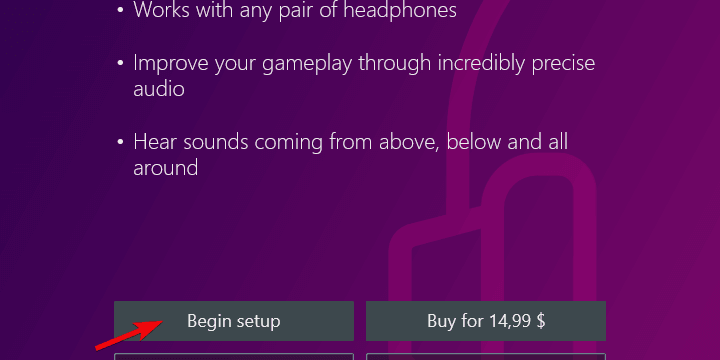
9. Select Configure PC settings and choose Atmos for Headphones from the drop-down menu.

10. Take a look at some demos and listen for differences in the sound.
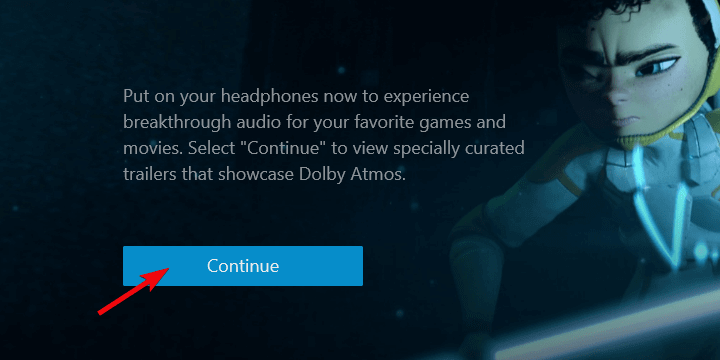
Windows Sonic is a built-in feature that you can’t change or remove. Thus, the problem is likely to be somewhere in the system.
However, Dolby Atmos is a third-party service that can only be bought through the Microsoft Store. So, you can try to change it and try again.
Also, make sure that you’re playing content that works well with this technology. The Dolby Atmos-enabled hardware is by far the best at running the software.
If you can’t use Dolby Atmos, maybe the Windows alternative for spatial sound, Windows Sonic, will be enough for you to get the job done.
Here are the steps:
1. Right-click on the Sound icon in the Notification area and select Playback device.
2. Right-click on your default playback device and click Properties.

3. Go the Spatial sound tab.
4. Select Windows Sonic from the drop-down menu and confirm changes.
Method 7. Update Windows
1. Open Settings by pressing Windows key + I.
2. Select Update & Security.
3. Under the Windows Update, click on the Check for updates button to see if there are any new updates.
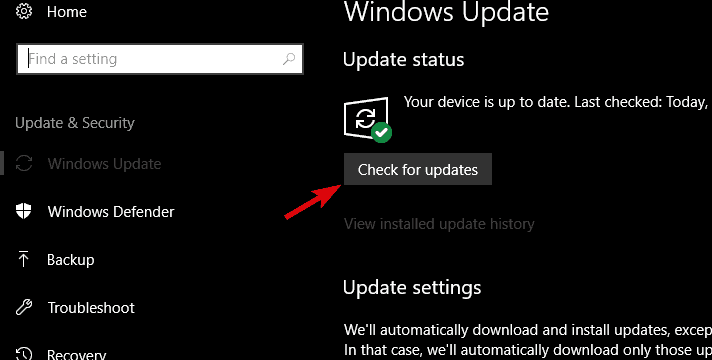
Check for updates and be patient, if none of the previous steps worked to fix your Dolby Atmos/Spatial sound.
As the case has shown on other occasions, everything worked out after a new update.
As you already know, Windows 10 users get new software updates without having to ask. But, just in case, you can try to look for updates on your own.
That should work. Send a report ticket to Microsoft and Dolby if you can’t figure out how to solve the problem at hand.
In this video, I will show you how to fix Dolby Atmos not working in Windows 10:
Dolby Atmos/Spatial sound problems: If you have any questions or other ideas for how to fix them, post them in the comments below.






